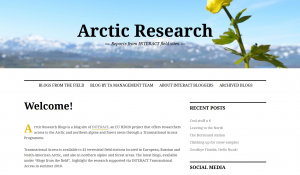When things slow down during the summer holiday season, in arcticDefinitions of the Arctic vary according to environmental, geographical, political, cultural and scientific perspectives. Some scientists define the Arctic as areas having a high latitude, long winters, short, cool summers,... More research they are just speeding up! You can join the action by following the INTERACT Arctic Research Blogs! We are proud to host altogether eight blogs this summer representing a range of scientific disciplines from all over the arcticDefinitions of the Arctic vary according to environmental, geographical, political, cultural and scientific perspectives. Some scientists define the Arctic as areas having a high latitude, long winters, short, cool summers,... More. Six of the blogs have already started with support from INTERACT Transnational Access, sharing exciting stories and awesome pics fresh from the field work. You can meet our bloggers by visiting the About INTERACT bloggers.The six blogs already featured at ArcticDefinitions of the Arctic vary according to environmental, geographical, political, cultural and scientific perspectives. Some scientists define the Arctic as areas having a high latitude, long winters, short, cool summers,... More Research blogs include:

Faroe Islands – water, wind and weather by Catherine Moody about the composition of organic matter in surface waters, and the degradability of such organic matter with the potential for greenhouse gasA gas found in the earth's atmosphere that traps heat radiated from the surface of the earth, and causes the earth's temperature to rise. The term comes from the fact... More emissions from water.
Arctic Greening or Arctic Drowning? by Rúna Magnússon, sharing her field work on vegetation-permafrost interactions, taking her to the remote and exotic Chokurdakh TundraA type of ecosystem in which tree growth is limited by low temperatures. The origin of the word is from from the Kildin Sami word t?ndâr, meaning "uplands" or "treeless mountain tract". In the northern... More Research Station in Russia.
Cold Ice in a Warm Bath by Adrian Dye, Francesca Falcini and Joe Mallalieu, blogging about their glaciological field work at the Tarfala Research Station in northern Sweden.
GrAINFluxes: Greenlandic Atmospheric, Isotopic, and Nutrient Fluxes by Andrea Pain, Ellen Martin and Jonathan Martin, who are escaping the warmth of Florida to the Kobbefjord Field Station of the Greenland Institute of Natural Resources in Greenland to study how deglaciation impacts the fluxes of water and solutes to the ocean.
OMI-perm: Organo-Mineral Interactions from permafrost disturbance to sediment sink by a group of three researchers, Lisa Bröder, Julen Fouché and Catherine Hirst, who share their journey to Zackenberg Research Station in Greenland to study the role and evolution of organo-mineral interactions in preventing permafrostPermafrost is frozen ground that remains at or below zero degrees Celsius (32 degrees Fahrenheit) for two or more years. It forms in regions where the mean annual temperature is... More organic matter decomposition.
Some Like it Hot, that takes you to the Polish Polar Station in Hornsund, where Jan Kavan and his team set up runoff measurements to compare the runoff from glaciated and unglaciated catchments and establish the relation between runoff, atmospheric forcings and glacierA glacier is a large, persistent body of land-based ice that forms over many years where the accumulation of snow is greater than its loss (ablation). The ice in a... More ablationEncompasses all the ways in which ice mass is lost from the surface of a glacier or ice sheet, such as melting at the surface or the base (underside), and evaporation. However, ablation... More.
Stay tuned to an exciting season of INTERACT ArcticDefinitions of the Arctic vary according to environmental, geographical, political, cultural and scientific perspectives. Some scientists define the Arctic as areas having a high latitude, long winters, short, cool summers,... More Research Blogs, and do not forget to also follow our Instagram account @EU_INTERACT to find other awesome pics and instagram stories captured by our TA users and stations in the INTERACT network!
